Illustrated Hegel-Biographie V. 1.10.1
YOUTH IN STUTTGART AND TÜBINGEN
GEORG WILHELM FRIEDRICH HEGEL (his close family called him simply, “Wilhelm”) was born in Stuttgart on the 27th of August 1770.
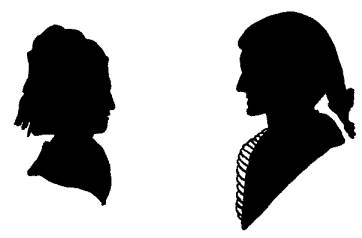
His father Georg Ludwig (1733-1799) born in Tübingen to a family of civil servants and pastors, was an ordinary revenue officer in the fiscal service of Württemberg (1766 “Rentkammersekretär”,1796 “Rentenkammer-Expeditionsrat”). His mother, Maria Magdalena Louisa (nee Fromm, 1741-1783) came from a well-to-do family of Stuttgart, home to some of the foremost theologians, lawyers and high-ranking bureaucrats in Württemberg. She was well-educated for her time and had sufficient scholastic ability to teach young Hegel the elements of Latin.
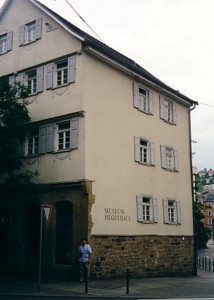
Georg Ludwig and Maria Magdalena married in September 29, 1769. Hegel was the oldest of their three children (four more children died short after their birth in 1771, 1774,1777 and 1779). His sister, Christiane Louisa (1773-1832), who had worked 1807-1814 as governess for Count Josef von Berlichingen, contracted a nervous disorder in 1820, and was committed to an asylum (Heilanstalt Zwiefalten) for one year, after which Christiane’s relationship with Hegel suffered. (Three months after Hegel’s death, she drowned herself in the Nagold river). Hegel’s brother Georg Ludwig (1776-1812), the youngest, died fighting as an officer for Napoleon’s army in the Russian Campaign.
By the age of three Hegel attended German School. By the age of five, Latin school. He was educated at the Stuttgart Gymnasium (grammar school) between the ages of seven and eighteen. He was a serious, hard-working and successful student. He showed remarkable curiosity, a wide extent of interests and readings.
At eight, Hegel obtained the complete works of Shakespeare (18 volumes, in a German translation) from his beloved teacher, Löffler. Among the Greek writers his favourites were Plato, Socrates, Homer and Aristotle. He was inspired by the Greek tragedians, Euripides and Sophocles, and at a young age Hegel translated Sophocles’, ANTIGONE (in prose, and a second time at university as poem). He read the NEW TESTAMENT in Greek, as well as Homer’s ILIAD. Among the Latin authors his favourites were Livius, Cicero and Epictetus, and he also translated some of their works.
Hegel also studied Hebrew, starting at fifth grade, for two hours weekly. He seems to have learned French in noon-time elective courses offered by his school. He also learned English, perhaps from a private tutor, as we find him reading English newspapers later in Frankfurt.
In the home of Hegel’s parents, lectures were held by Jakob Friedrich Abel, the leader of the Stuttgart Illuminati and Schiller’s favorite teacher, who also served as Hegel’s mentor. He certainly influenced Hegel in the spirit of the Enlightenment.
Hegel’s documented reading from this time shows this late-Enlightenment influence. Hegel’s favourite German literature included Goethe’s, WERTHER,Schiller’s, FIESKO, Lessing’s, NATHAN, Klopstock’s, MESSIAS and Hippel’s LEBENSLÄUFE. From German Philosophy he studied Moses Mendelssohn’s, PHAEDON, and Wolf’s, LOGIC.
Hegel’s favourite games were chess and cards. He took up the habit of snuff. 1783, at age thirteen, Hegel experienced his first tragedy; he lost his dear and affectionate mother due to bile fever. Hegel himself and his sister caught the same disease at the same time, and nearly died themselves.
His main writing, aside from his translations, was a diary (partly in Latin) kept at intervals during eighteen months (starting when he was about fifteen, June 26, 1785 until January 7, 1787, he was seventeen years old). But the main feature of his studies was his love of notes and excerpts that he started at this time and unremittingly collected and preserved. This collection, alphabetically arranged, contained notes on classical authors, passages from newspapers, treatises on philology, histories of literature, arithmetic, geometry, applied mathematics, physics, morals, psychology and education from the standard works of the period. These notes absorbed and integrated raw materials for further elaboration, yet he was not merely passive in these student writings; young Hegel also wrote essays expressing admiration of the Classical world, an admiration he never lost.

When Hegel was eighteen years old, in the autumn of 1788, he entered at the Stift Theological Seminary in Tübingen. However, he soon showed little interest in traditional theology, as it was taught in Tübingen: his sermons were boring and he found more congenial reading in the Classics. He still believed in the advantages of studying the Classics, as he proclaimed in his very first essay. He preferred Aristotle (whom he studied intensively at this time), Schiller, Spinoza, Jacobi, Herder, Voltaire, and he held a special fondness for the writings of Rousseau.
Hegel found the atmosphere in Tübingen stifling. Stift’s strict and artificial discipline seemed to him a pale heritage of a dismal past. The explosion of the French Revolution meant for many students and probably for Hegel, the beginning of a new era in which the Tübingen Stift held a lower place. Still, Hegel continued to love learning and to succeed in his academic career. After only two years Hegel obtained the degree of PhD (“Magister der Philosophie”) in September 1790. At twenty-three, in September 1793, he obtained the coveted theological certificate. Hegel’s graduation certificate stated that he had good abilities, but was of middling industry and middling knowledge. The original certificate stated that Hegel devoted a lot of efforts to Philosophy. This was written in Latin as follows: “Philosophiae multam operam impendit.” However, a copyist’s error transcribed the word, “multam,” (a lot, many) as “nullam” (none) in later reports. Many biographies repeat the later, incorrect version. (See document and comment 46 in Nicolin’s 1977 edition of “Briefe von und an Hegel”, Vol IV/1 “Dokumente und Materialien zur Biographie”)
Hegel’s somber appearance won him the title, “old man”, from his fellow students, yet he always joined their activities for hikes, beer-drinking and carousing. As Terry Pinkard remarked in his biography of Hegel:
“However rebellious against the ways of the Seminary Hegel became, he remained the industrious, serious fellow he always was; his friends at the Seminary referred to him by the nickname ‘the old man’ (..). He was not content with simply pub crawling, carousing and making merry; he was still reading quite a bit and still remained extremely serious about learning”. (Pinkard, 1996)
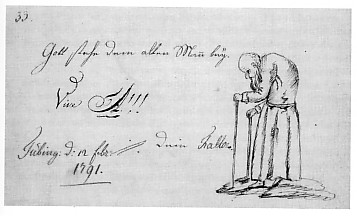
THE OLD MAN (Hegel’s Stammbuch - Universitätsbibliothek Stadt Tübingen)
A page from Hegel’s album at the Tübingen Stift, where with a message by classmate Georg Friedrich Fallot: “May God help the old man; Vive A!”.Hegel gained most from intellectual exchanges with his famous room-mates Hölderlin and Schelling. From Hölderlin he learned to love the old Greeks even more, as the quasi-Kantian theology of his teachers bored him more and more. Schelling joined these new ideas. They all protested against the political and ecclesiastical inertia of their home State, and formulated new doctrines of freedom and reason.
In summer 1792, Hegel is called the “most enthusiastic speaker of freedom and equality” by the members of a revolutionary-patriotic student club that brought ideas from the French Revolution into Tübingen. They read French newspapers with great interest, and Hegel and Hölderlin are called “uncouth Jacobins” by their opponents. With a group of like-minded students they study Plato, Kant and F.H. Jacobi. On July 14, 1792, Hegel, Hölderlin and Schelling, who had just translated LA MARSEILLAISE into German, are reported to have planted a liberty tree on a meadow near the Tübingen Seminary. While this old story is doubted (see Dieter Henrich 1965: ‘Leutwein über Hegel’ in ‘Hegel Studien’ 3), the story itself may help to illustrate their political leanings.
“HOFMEISTER” IN BERNE AND FRANKFURT

Hegel did not enter the ministry after leaving college, rather, hoping for some leisure to study philosophy and Greek literature, he became a private tutor. In 1793, with the help of Johannes Brodhag (Innkeeper of Schiller’s favourite Inn in Stuttgart, the “Ochsen”), Hegel obtained work in Berne, tutoring the children of Captain Karl Friedrich von Steiger. In those days a young Magister in Theology from the middle class could choose between the position of tutor (“Hofmeister”) or pastor. Both Hölderlin and Hegel chose the burdens of this profession. As Anthony La Vopa argues in his essay GRACE, TALENT AND MERIT: “one of the standard laments by the close of the century was that parents inflated expectations were in absurd contrast to the paltry compensation and demeaning terms of employment tutors had to endure”.
Like all truly important citizens of Berne, Captain (“Dragonerhauptmann”) Karl Friedrich von Steiger (1754-1841) was a member of the legislature, the Great Council of Berne (“Conseil Souverain”). He assumed this post after the death of his father in 1785. Both Karl Friedrich and his father Christoph von Steiger (1725-1785) once belonged to the Bernese Oligarchy, but they became quite critical of that class and retreated from it. The relatively liberal ideas of the Steigers fell on fertile soil with Hegel. They also introduced Hegel to the contemporary social and political situation in Berne.
According to Martin Bondeli, an expert on Hegel’s Berne period, Hegel and the Steigers had some lively debates about politics and philosophy, yet overall the young Hegel was pleased to see the Steiger family bestow their favours upon Science (“Wissenschaft”) and Education (“Bildung”), and to hear their criticisms of Bernese politics.
In Winter, the Steigers would stay in their Bernese Home at Junkerngasse 51, near the Bernese public library. In Summer, they would stay at their wine farm in Tschugg bei Erlach (in the outskirts of Berne). There Hegel would make use of their private library, founded by Christoph von Steiger the Elder (1651-1731). The library had been expanded by Christoph von Steiger, a statesman who took a special interest especially in political literature in ancient times, and from the end of medieval times up to modern times. This library was a rich source of French and English authors uncommon in Berne. Karl Friedrich von Steiger contributed less to this library, although he did later catalogue its 3,871 books. (the full catalogue is revealed in “Hegel in der Schweiz”, edited by H. Schneider and N. Waszek).
In Tschugg Hegel read a considerable portion of this library, with special attention to Montesquieu (ESPRIT DES LOIX), as well as Grotius, Hobbes, Hume, Leibniz, Locke, Macchiavelli, Rousseau, Shaftesbury, Spinoza, Thucydides and Voltaire. These authors were also among the favourites of Christoph von Steiger. We may safely say that Hegel in his Berne period laid the groundwork for his wide knowledge of philosophy, social studies, politics, economics and political economy. One can trace this wide and specialized knowledge within Hegel’s famous, PHILOSOPHY OF RIGHT (1821).
In Berne Hegel maintained a focus on the turmoil of political events in France. His sympathies went soon to the “Girondist” faction, as he grew increasingly disillusioned with the excessive brutality of the Reign of Terror. Contrary to many of his contemporaries, he kept an optimistic yet sober consideration of the changes introduced by the successive revolutionary governments in France. He never abandoned his earlier positive judgement on the achievements of the French Revolution.
Hegel’s interests in revolutionary politics and his sympathies for the Girondist cause are witnessed by his detailed translation into German (accompanied by an extensive favourable commentary) of Jean-Jacques Cart pamphlet “on the former political relationship between Vaud and the City of Berne”. Cart’s pamphlet was a violent denunciation against the tyrannical oppression exerted by the Bernese aristocracy on the citizens of Vaud. Cart applied the principles emerged from the French Revolution to the situation of Vaud and supported an intervention to force and end to the oppression. Bernese authorities banned Cart and his pamphlet, so Cart had to flee to France, where he could count on the protection of members of the Girondist faction. Later, a military intervention by France gave Vaud its independence from Berne.
In his (anonymous) translation of Cart’s pamphlet, Hegel added a clear admonishment to all small German princes (“Discite justitiam moniti”), making it clear that France would have put an end to tyranny through military occupation, as the principles of the Revolution were invincible. Both translation and commentary were published anonymously in 1798, when Hegel had left Berne for Frankfurt. The book was in several copies in Hegel’s private library, however Hegel’s authorship was only discovered 1909, 111 years later.
Another factor in his philosophical growth came from his study of Christianity. Under the impulse given by Lessing and Kant he turned to the original records of Christianity, and attempted to construe for himself the real significance of Christ. The essays he wrote for himself became noteworthy only when, more than a century later, they were published by Hermann Nohl as a part of ‘Hegels theologische Jugendschriften’ (1907, translated 1948 by T. M. Knox as ‘Early Theological Writings’). (The interpretations at that time ranged from Wilhelm Dilthey’s “Die Jugendgeschichte Hegel” to its criticism by Georg Lukacs in “The young Hegel”. Walter Jäschke summarizes today’s comprehensive philological criticism of the edition in his “Hegel Handbuch”).
He wrote a life of Jesus, in which Jesus was simply the son of Joseph and Mary. He did not stop to criticize as a philologist, and ignored the miraculous. He asked for the secret contained in the conduct and sayings of this man which made him the hope of the human race. Jesus appeared as revealing the unity with God in which the Greeks in their best days unwittingly rejoiced, and as lifting the eyes of the Jews from a lawgiver who metes out punishment on the transgressor, to the destiny which in the Greek conception falls on the just no less than on the unjust.
The interest of these ideas is twofold. In Jesus Hegel finds the expression for something higher than mere morality: he finds a noble spirit which rises above the contrasts of virtue and vice into the concrete life, seeing the infinite always embracing our finitude, and proclaiming the divine which is in man and cannot be overcome by error and evil, unless the man close his eyes and ears to the godlike presence within him. In religious life, in short, he finds the principle which reconciles the opposition of the temporal mind. But, secondly, the general source of the doctrine that life is higher than all its incidents is of interest. He does not free himself from the current theology either by rational moralizing like Kant, or by bold speculative synthesis like Fichte and Schelling. He finds his panacea in the concrete life of humanity. But although he goes to the Scriptures, and tastes the mystical spirit of the medieval saints, the Christ of his conception has traits that seem borrowed from Socrates and from the heroes of Attic tragedy, who suffer much and yet smile gently on a destiny to which they were reconciled. Instead of the Hebraic doctrine of a Jesus punished for our sins, we have the Hellenic idea of a man who is calmly tranquil in the consciousness of his unity with God. During these years Hegel maintained a crisp correspondence with Schelling and Hölderlin. Hölderlin in Jena had been following Fichte’s career with an enthusiasm that influenced Hegel significantly. Schelling, the child prodigy, already on the way to fame, kept Hegel abreast of German speculation. These three friends seemed intent on forcing their contemporary theologians into the daylight, grudging any aid they might hope to obtain from Kant’s postulates of God, as a crown for the edifice of their traditional Ethics.
According to Martin Bondeli in his books “Hegel in Bern” 1990, “Der Kantianismus des jungen Hegel” 1997 and “Hegels Denkentwicklung in der Berner und Frankfurter Zeit” 1999, Hegel was not as lonely in Berne as sometimes reported, judging from his letters to Schelling. Rather, as a “practical Kantian”, he surrounded himself with a circle of like-minded men. Hegel met the painter, V. Sonnenschein, the writer, K. Oelsner (who wrote about the French Revolution), the active Jacobin, J. Baggesen (friend of Reinhold, Jacobi and Fichte) and the writer, E. von Berlepsch (friend of P.A. Stapfer). These men were part of the circle of the Bernese Kantian and Fichtean intellectuals of their time. Sonnenschein taught at the political institute (200 meters from Junkerngasse 51), where the two most important Kantians of Berne, J. Ith and P.A. Stapfer also taught. In 1798 Stapfer became temporary Minsiter of Education of the Helvetic Republic. Since the visit of Fichte in Berne (late 1793), a Fichtian movement developed in Berne, especially by the help of J. Baggesen. Since 1795, regular contacts between these young Bernese scholars and the Jenses Crircles around Fichte were commonplace. All the important heads of the literary society of Jena had visited Berne and its surroundings since 1796. In the 1790’s, Oelser, Stapfer and Ith translated French writings into German and vice versa, for example, Stapfer translated Kant into French.
In May 1795, Hegel visited Geneva. We can speculate that Hegel’s interest was not solely in exploring the city of his admired Rousseau. Historical research on Hegel has largely overlooked the significant influence the French Revolution had on Geneva at that time. On December 28, 1792, “revolutionary committees” took over government affairs, and a “National Convention” drafted a constitution, which was accepted on February 5, 1794, eliminating all class barriers. Geneva was shaped by political clubs, the Montagnards, the Sansculottes, and experienced a period of the Reign of Terror after a popular uprising on July 19, 1794. During this time, a revolutionary tribunal sentenced 37 people to death within 18 days, of whom 11 were executed. After Robespierre’s fall in late July 1794, a similarly bloody counter-revolution followed. The city only returned to peace a year after Hegel’s visit. Consequently, historians have viewed 18th-century Geneva as a veritable “laboratory of the revolution.”
In July and August 1796, Hegel and three other tutors made a pleasant journey through the Bernese Oberland , and Hegel kept a detailed diary. He was delighted with the varied play of the waterfalls, but he clearly beheld the squalor of Swiss peasant life. Glaciers and rocks called forth no raptures.
“The spectacle of these eternally dead masses gave me nothing but the monotonous and at last tedious idea, ‘Es ist so.’ [it is so]”
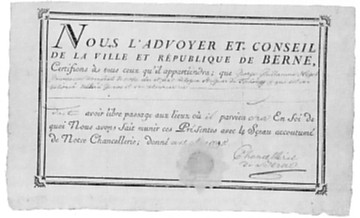
Towards the end of his contract in Bern, Hegel, through the mediation of Hölderlin, who was then a tutor in Frankfurt, obtained a tutoring position with the family of Mr. Johann Noe Gogel, a Freemason wine merchant and banker who lived “Am Roßmarkt”, right in the center of Frankfurt ( January 1797). The new position provided him with more free time and the social interaction he needed. Hegel now had a new objective in sight - a regular income that would enable him to launch a more rewarding academic career.
According to Alexandra Birkner in “Hegel’s Sister” (pp. 111-124), from November (1799 to late summer (1800, Hegel used his new Frankfurt home as a base for a revolutionary courier role. He personally delivered letters from the Württemberg revolutionaries to the French government in Mainz, which was under French occupation at the time. However, his activities were exposed in Stuttgart in the late summer of 1800. As a result, Hegel’s sister, who had been cooperating with the revolutionaries, had to leave Stuttgart.
Hegel continued in Frankfurt his incessant study of economics and government, including Edward Gibbon’s FALL OF THE ROMAN EMPIRE, Hume, and DE L’ESPRIT DES LOIS by Montesquieu. Rosenkranz (1805- 1879, Hegel’s first biographer and Hegelian professor of Philosophy on Kant’s former seat in Königsberg from 1833 up to his death ) states that Hegel’s interest in economic questions began in Frankfurt. It was primarily conditions in England that excited his curiosity, and he regularly read the newspapers and made detailed notes from them.
His interest in daily politics greatly increased. He seemed to be fascinated by the relations of Commerce and Property, especially in England. His excerpts from English newspapers show that Hegel followed with keen interest the Parliamentary debates upon the Bill of 1796, the so-called Poor Laws about public welfare as managed by the nobility and the aristocracy of wealth as they attempted to appease the rage of indigent masses. Hegel also followed the news about the reform of the Prussian civil law (“Landrecht”). In Rosenkranz’s words:
“All of Hegel’s ideas about the nature of civil society, about need and labor, about the division of labour and the wealth of the estates, about poverty, the police, taxation, etc., are finally concentrated in a commentary on the German translation of Steuart’s book on political economy, INQUIRY INTO THE PRINCIPLES OF POLITICAL ECONOMY, which he wrote between 19th February and 16th May 1799, and which has survived intact [Hegel.Net: but not to our time]. It contains a number of magnificent insights into politics and history and many subtle observations.”
(page 85-86 in “Georg Wilhelm Friedrich Hegels Leben” by Karl Rosenkranz, Berlin 1844, see also Georg Lukács: “The Young Hegel” )
Here, as in his criticisms of Kant’s ethical writings during this period, Hegel aimed at correcting the abstract discussion of a topic by treating it in its systematic inter-connections. Church and state, law and morality, commerce and art, were reduced to factors in the totality of human life from which specialists had isolated them.
Further evidence of Hegel’s attention to contemporary politics is found in two unpublished essays – one of which was written in 1798, namely, “On the Internal Condition of Württemberg in Recent Times, particularly on the Violation of the Magistrate’s Constitution.” The other essay was a criticism on the German Constitution, probably written not long after the peace of Lunéville (1801). Both essays are critical rather than constructive.
In the first essay, devoted to the situation in Württemberg, his own home country, Hegel showed how the passivity of the committee of estates in Württemberg had favoured a policy letting the Court usurp senior officials as compliant servants. This essay situates itself in the agitated debate on the deep Württemberg institutional crisis that revealed the old Estates and the Duke in conflict.

The Estates wished to defend their traditional right to appoint their elected magistrates as representatives of Württemberg’s inhabitants and to meet in a Diet. They were split between those who wanted to preserve their entrenched feudal interests and those who advised more radical changes, inspired by the principles of the French Revolution. Among the more radical advisors was the famous publisher from Tübingen and Hegel’s friend, J. Friedrich Cotta. Hegel intervenes in the debate with an essay recommending a system of representation in which the Diet would have regular sessions. He saw advantages in changing the Constitution of the Estates, still he wondered whether such an improved system could work in the actual conditions of his native province. As main feature in the pamphlet, Hegel recognized that a spirit of reform that was open and free is abroad, in France. Hegel attempted to publish this essay, but he was discouraged by some friends in Stuttgart who thought it was too Francophile.
In his second unpublished political essay, Hegel begins: “Germany is no longer a state.” Referring the collapse of the empire to the retention of feudal forms and to the continuance of religious animosities, Hegel looked forward to reorganization by a central power (Austria) wielding an imperial army, and by a representative body elected by the geographical districts of the empire. But such a result, he saw well, could only be the outcome of violence - of “blood and iron”. The philosopher did not pose as a practical statesman; he described the German empire in its nullity as a conception without existence in fact. In such a situation it was the business of the philosopher to draw the outlines of the coming epoch as they took shape before his eyes. Even the ordinary eye saw only the disintegration of the old forms of social life.
His old interest in the religious question arose again in a more philosophical form. Hegel begins by contrasting positive religion, natural religion, and the ideal of an inner upsurge of morality that crowns a human life, as the one, universal and perennial spirituality, appropriate for every clime and age. He regarded a positive religion as authoritarian, imposed upon the heart by external or political forces. He regarded a natural religion as the spontaneous development of the national conscience, variable in varying circumstances, and subject to change as circumstances change. The perfect religion of Jesus, said Hegel, became a positive religion when the ideals of love and reconciliation were presented as valuable only because Jesus was an authority, and not because they harmonized with the inner heart of humanity. Even at this early stage in his writings, Hegel maintained that philosophy must never abandon the finite in its search for the infinite. In writings such as these, Hegel gradually came to regard reason as the clearest means of grasping the spiritual truth; preferable for philosophers over representative religion in both its positive and natural forms.
JENA: STRUGGLING FOR A LIVING AS A PROFESSOR
Natural circumstances eventually helped Hegel fulfill his aspirations when his father died in January 1799. Hegel received a modest inheritance, 3,154 gulden, that enabled him to think once more of a studious life. At the close of 1800 we find him asking Schelling for letters of introduction to Bamberg, where with cheap living and good beer he hoped to prepare himself for the intellectual excitement of Jena. The upshot was that Hegel arrived at Jena in January 1801. An end had already come to the brilliant epoch at Jena, when the Romantic poets, Tieck, Novalis and the Schlegels made it the headquarters of their fantastic mysticism, and Fichte turned the results of Kant into the banner of revolutionary ideas. Schelling was the chief philosophical lion of the time; in some quarters Hegel was spoken of as a new champion summoned to help him in his struggle against the more prosaic pursuers of Kant. Hegel’s first performance seemed to justify the rumor; an essay on ‘the difference between the philosophic systems of Fichte and Schelling’ (1801, translated by H.S. Harris and W. Cerf 1977), tending in the main to support Schelling. Still more striking was their cooperation in the Kritisches Journal der Philosophie (Critical Journal of Philosophy), which Schelling and Hegel wrote together during 1802-1803. So latent was the difference between them at this epoch that in one or two cases it is not possible to determine by whom the essay was written. Even later foreign critics like Cousin saw much that was alike in the two writers, and did not hesitate to regard Hegel as a disciple of Schelling.
The articles Hegel wrote in that journal include so important ones like his “Glauben und Wissen” (July 1802, translated as “Faith and Knowledge” by W. Cerf and H.S. Harris 1977), a critique of Kant, Jacobi and Fichte or his “Über die wissenschaftliche Behandlungsarten des Naturrechtes, seine Stelle in der praktischen Philosophie und sein Verhältnis zu den positiven Rechtswissenschaften” (November 1802, translated as “Natural Law” by T.M. Knox 1975).
The theme of the dissertation by which Hegel qualified for the position of Privatdozent (De orbitis planetarum, 1801) was probably chosen under the influence of Schelling’s philosophy of nature. Hegel, after discussing the Titus-Bode ‘law’ of distances between Planets, mentions that with the same right, one could use a sequence of distances derived from a numeric sequence from Plato. The later sequence did not leave a gap between Mars and Jupiter, so seemed to fit better to the known sequence of planets of that time, in contrast to the Bode-Titus law, which needed to postulate a Planet between Mars and Jupiter. So, Hegel concluded, if the sequence derived from Plato is correct (Hegel did not write that it was), than one would not find a Planet between Mars and Jupiter.
However, Giuseppe Piazzi had already discovered an object on January 1, 1801, in exactly that place. Spectral analysis (a method used today to distinguish between Comets and Planets) was unknown in those days, so Piazzi could not be sure whether this was a Planet, a Comet, or some other body, but it was surely a significant body between Mars and Jupiter. Today we know it as the first of the asteroids (Ceres). Piazzi was able to follow this new heavenly body for nine degrees (about 2.5% of it’s complete tour around the sun). H.W.M. Olbers observed the new object again on December 7, 1801. Until that date the discovery of a new heavenly body was still debated. In November, 1802, Berlin astronomer W. Herschel (who discovered Uranus) concluded that Ceres was a Comet, not a Planet.
So, in August 1801, when Hegel had qualified with his dissertation, most probably had read in the newspapers about the discovery of the sight of the new object (according to the philological addendum to Hegel Werke 5), but did not mention the new discovery (In a footnote of the 1st edition of his Encyclopaedia, Hegel later explicit mentioned that he no longer considered that sequence of his dissertation). Hegel’s later critics have made this appear to be a scientific error, or worse, a methodological error on Hegel’s part. They tried to make this the ground of their attack on Hegel’s allegedly apriori philosophy (see also Prof.Neuser’s further research on this subject).
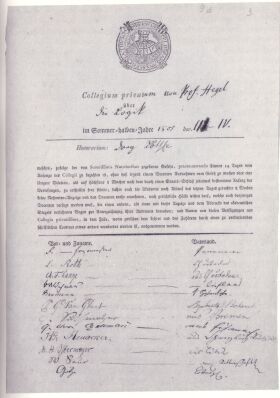
Hegel’s lectures on logic and metaphysics in the winter of 1801- 1802 were attended by eleven students. After the departure of Schelling from Jena to Würzburg in the middle of 1803, Hegel was left to work out his own views. Besides philosophical studies, where he now again read Aristotle and Plato, he read Homer and the Greek tragedians, made extracts from books, attended lectures on physiology, and dabbled in other sciences.
In 1804 he lectured on his whole system to a class of about thirty (among them the Dutch van Ghert and Gabler, who later became Hegel’s successor as Professor of Philosophy in Berlin), although the average attendance was rather less. He also lectured on mathematics at least once. As he taught, he continually improved his original system, and notice after notice of his lectures promised a text-book of philosophy - which was always postponed.
At Weimar in February 1805 Hegel was made a Professor Extraordinarius, and in July 1806 he drew his first and only stipend – 100 thalers. At Jena, though some of his students became attached to him, Hegel was no more popular lecturer than K.C.F. Krause. The ordinary student found J. F. Fries more intelligible. Later in 1805, when several lecturers resigned because of diminished classes, he wrote to Johann Heinrich Voss, applying for a job in Heidelberg, suggesting that his philosophy might find more congenial soil there. However, that employment application bore no fruit.
Of the lectures of that period there still remain considerable notes. The language often had a theological tinge (never entirely absent), as when the “idea” was spoken of, or “the night of the divine mystery”, or the dialectic of the absolute called the “course of the divine life”;. Still his view was growing clearer, and his difference from Schelling more obvious. Both Schelling and Hegel make much of art, but the aesthetic model of Schelling was found in the contemporary world, where art was a special sphere and the artist a separate profession without a necessary, intimate connection with the epoch and nation. By contrast, the model of Hegel was found in those works of national art in which art is not a separate part, but an aspect of common life, and the artist is not a mere individual but a concentration of the power of beauty and the passion of the whole community. Hegel wrote in his lectures on the history of philosophy, which laid the foundation for his ‘Phäomenologie des Geistes’ (Bamberg, 1807, translated by J.B. Baillie 1910, revised 1931, in a more accurate version by A.V. Miller 1977):
“Such art is the common good and the work of all. Each generation hands it on beautified to the next; each has done something to give utterance to the universal thought. Those who are said to have genius have acquired some special aptitude by which they render the general shapes of the nation their own work, one in one point, another in another. What they produce is not their invention, but the invention of the whole nation; or rather, what they find is that the whole nation has found its true nature. Each, as it were, piles up his stone. So too does the artist. Somehow he has the good fortune to come last, and when he places his stone the arch stands self-supported.”
Hegel, as we have already seen, was fully aware of the change that was coming over the world. He concludes:
“A new epoch has arisen. It seems as if the world-spirit had now succeeded in freeing itself from all foreign objective existence, and finally apprehending itself as absolute mind.”
WAITING FOR FAME IN BAMBERG AND NUREMBERG
On October 14th, 1806, Napoleon arrived at Jena. Hegel, like Goethe, felt no patriotic shudder at the national disaster, and in Prussia he saw only a corrupt and conceited bureaucracy. Writing to his friend F. J. Niethammer (1766-1848) on the day before the battle, he speaks of the “world-soul”, the emperor, and with satisfaction of the probable overthrow of the Prussians. His manuscripts were his main care; doubtful of the safety of his last dispatch to Bamberg, disturbed by the French soldiers in his lodgings, he hurried with the last pages of the Phänomenologie to take refuge in the pro-rector’s house.
Hegel’s fortunes were now at the lowest ebb. Without means, and obliged to borrow from Niethammer, he had no further hopes from the impoverished university. Moreover, his life as a bachelor took an unforeseen turn when he impregnated his landlady and housekeeper. Christiane Charlotte Burkhardt (nee Fischer) gave birth on February 5, 1807 to Hegel’s illegitimate son, Georg Ludwig Friedrich Fischer. Little Ludwig was temporarily lodged at the house of Fromann, a well-known publisher in Jena. The philosopher had insufficient funds to support himself, and now he had to attend to the needs of his child and his forlorn lover, whom he had no intention of marrying.

Hegel had once before tried to get away from Jena, so he was glad to become editor of the Bamberger Zeitung (1807-1808). Hegel wrote no leading articles, although he kept the journal open amid various difficulties, overcoming - not without skill and shrewdness - several hurdles imposed by a strict and ideological Napoleonic censorship.
See his house in Bamerg (German webpage on Hegel in Bamberg)
Niethammer finally intervened; in October 1808, Hegel was offered the rectorship of the Aegidien-Gymnasium in Nürnberg, a post which he held from December 1808 to August 1816. (The school still exists today; its name is now, Melanchton Gymnasium, and it has become one of the most exclusive in the city, perhaps also thanks to the fame of its former rector and professor.)
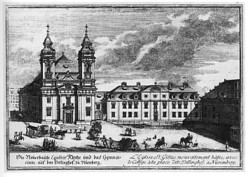
Hegel was called to fulfill Niethammer’s project on the reforming of education and school organization. Bavaria at this time was modernizing her institutions. The school system was reorganized by new regulations, in accordance with which Hegel wrote a series of lessons in the outlines of philosophy - ethical, logical and psychological, published in 1840 by Rosenkranz from Hegel’s papers as ‘Philosophical Propaedeutics’ (translated by A.V. Miller, 1986). Hegel struggled against opposition and conservatism from the Bavarian administration, still he succeeded both as an administrator and as a teacher.
As a teacher and schoolmaster, Hegel inspired confidence in his pupils and maintained discipline without pedantic interference in their associations and sports. On prize-days his addresses summing up the history of the school year discussed a topic of general interest. Five of these addresses are preserved. The first is an exposition of the advantages of a classical training, when it is not confined merely to grammar. Hegel wrote:
“The perfection and grandeur of the master-works of Greek and Roman literature must be the intellectual bath, the secular baptism, which gives the first and unfading tone and tincture of taste and science.”
In another address, speaking of the introduction of military exercises at school, Hegel says:
“These exercises, while not intended to withdraw the students from their more immediate duty, so far as they have any calling to it, still remind them of the possibility that every one, whatever rank in society he may belong to, may one day have to defend his country and his king, or help to that end. This duty, which is natural to all, was formerly recognized by every citizen, though whole ranks in the state have become strangers to the very idea of it.”
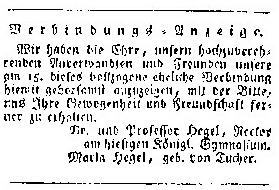
On September 16, 1811 Hegel married Maria(“Marie”) Helena Susanna von Tucher (1791-1855, (not 1835 as written on her gravestone!), the oldest daughter of the Senator and city mayor (“Bürgermeister”) of Nürnberg, Freiherr Jobst Wilhelm Karl von Tucher (1762-1813), from an old patrician family of Nürnberg. She brought her husband no fortune, but the marriage was entirely happy. As husband, Hegel kept a careful record of income and expenditure. His income amounted at Nuremberg to 1,500 gulden and a house; at Heidelberg, as professor, he received about the same sum; at Berlin about 3,000 thalers. A year after the marriage, Marie gave birth to a daughter, who died shortly after her birth. Later, two sons were born to them; the elder, Friedrich Wilhelm Karl (b. June 7, 1813, d.1901), rose to eminence as a professor of medieval history in Erlangen. The younger, Thomas Immanuel Christian (b. September 24, 1814, d.1891), named after his godfather, Niethammer, followed a career as a Prussian bureaucrat, became trustee of the Prussian state treasure in 1858 and in 1868 president of the Konsistorium of the Evangelic Church for the Province of Brandenburg. This son of Hegel did not choose to become a philosopher, and in his theological position he became one of the leaders of the Orthodox party. Was this an ironic twist? Historians may ask whether he intended to challenge his father.
Later on, when already living in Heidelberg, Ludwig’s mother died, and the Hegel’s brought Ludwig home to live with them. Ludwig did not manage to integrate into his new family, and at age 19 (1826) he was forced to leave the household. Ludwig enrolled as a mercenary in the Dutch army and died of a fever in 1831 while serving in Batavia (Jakarta), only a few months before Hegel died. Possibly the news of Ludwig’s death never reached his father.
Hegel’s letters to his wife, written during his solitary holiday tours to Vienna, Prague, the Netherlands and Paris, breathe of kindly and happy affection. Hegel’s letters recall happy days spent together, confessing that, were it not because of his obligations, he would rather be at home, dividing his time between his books and his wife; commenting on the shop windows at Vienna and describing the straw hats of the Parisian ladies. this is a contrast to the writings of a professor of a profound philosophical system. But it shows that the enthusiasm which in his days of courtship moved him to verse had blossomed into a later age of domestic happiness.
In 1812 Hegel published his first volume of his’Wissenschaft der Logik’ (‘Science of Logic’) and the work was completed by the second volume in 1813 and a third in 1816 (translated by W.Wallace, 2nd ed. 1894, W.H. Johnston and L.G. Struthers 1929, and by A.V. Miller in 1969)). This work presented his system for the first time in what, with a few minor alterations, was its ultimate shape. These ideas found some audience in the world.
CORONATION OF A DREAM: PROFESSORSHIPS IN HEIDELBERG AND BERLIN
Towards the close of Hegel’s eighth session three professorships were almost simultaneously put within his grasp at Erlangen, Berlin and Heidelberg. The Prussian offer included a doubt that his long absence from university teaching might have made him rusty, so Hegel accepted the position at Heidelberg, as Fries had just gone to Jena (October 1816).
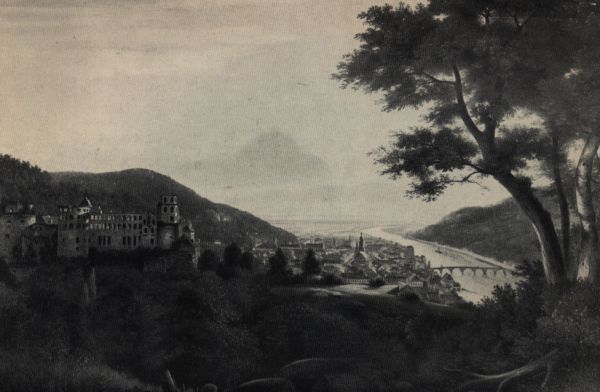
Only four students turned up for one of his courses. Others, however, on the encyclopaedia of philosophy and the history of philosophy drew classes of twenty to thirty. While there, Cousin first made his acquaintance, although they were to become more intimate later in Berlin. Among his pupils was Hermann Friedrich Wilhelm Hinrichs (1794-1861), to whose book, RELIGION IN ITS INWARDRELATION TO SCIENCE (1822), Hegel contributed an important Preface. Among his more unusual students was an Estonian baron, Boris d’Yrküll, who, after serving in the Russian army, came to Heidelberg to hear the wisdom of Hegel. Hegel’s books and lectures were both obscure to the baron, who, by Hegel’s advice, applied himself to simpler studies before he returned to the Hegelian system. Other students included Hinrichs and Carove.
At Heidelberg Hegel was also active in a literary domain. In 1817 he brought out the ‘ENZYKLOPÄDIE DER PHILOSOPHISCHEN WISSENSCHAFTEN IM GRUNDRISSE’ (1st edition 1817, expanded 2nd ed. 1827, again expanded 3rd ed. 1830, again appended with many “Zusätze” from his lectures and manuscripts in the “Freundesausgabe” of 1840, first translated into English 1959) for use at his lectures. It is the only exposition of the Hegelian system as a whole which historians possess directly from Hegel’s own hand. Its first part is an abbreviated version of the earlier SCIENCE OF LOGIC, called the “ENCYCLOPAEDIA LOGIC”, the “Shorter” or “Lesser Logic” (in German: “Kleine Logik”, “Shorter” or “Lesser Logic” (in German: “Kleine Logik”, already badly translated by W. Wallace in 1873) It is followed by the application of its principles to the Philosophy of Nature. Its third and last part consists of the Philosophy of Spirit/Mind(“Geist”).
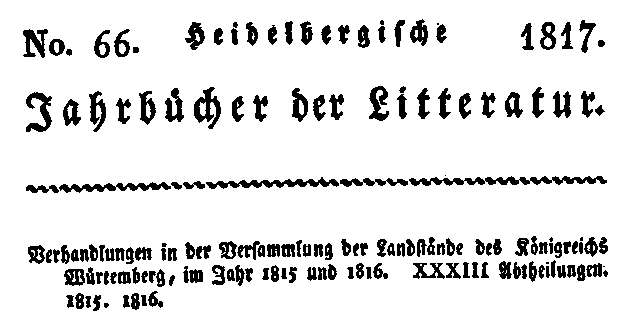
Besides this work he wrote two reviews as coeditor (responsible for the philological and philosophical part) of the “Heidelbergische Jahrbücher für Literatur” (see reproduction above) - the first on F. H. Jacobi, the other a political pamphlet entitled ‘a Criticism on the Transactions of the Estates of Württemberg in 1815-1816’, which drew violent criticism.
On March 15, 1815 King Frederick of Württemberg, at a meeting of the estates of his kingdom, laid before them the draft of a new Constitution. His Constitutional project, labelled as progressive by Prussian enlightened reformers, contained provisions for a “bicameral legislation with a popular representation”. Frederick’s successor, King Wilhelm I, called a Diet in order to obtain approval of the new Constitution by the Estates. The Diet responded angrily to this project, which would have led to a progressively marginal status of the power of the Estates, particularly on the question of finance. The Estates considered themselves champions of the old order; the traditional German or medieval methods to political decision and administration. In June, 1817, they rejected the King’s project. A large majority demanded the restitution of the old laws, though the kingdom now included a large population to which the old rights were strange. The King, now upset, tried then to impose his Constitution by force, bypassing the Estates’ decision. Hegel, in a political paper re-published (on the request of the republican Friedrich List) at Stuttgart, enthusiastically took the side of King Wilhelm I.
Hegel’s commitment to King Wilhelm’s views was consistent with his political philosophy (see his Lectures on the Philosophy of Right held in Heidelberg just one year later, the “Grundlinien” and all following lectures, only available in German). His position was a progressive one for Germany, as the philosopher criticized the backwardness of the bureaucracy and the landed interests.
In 1818 Hegel accepted a second offer of the chair of philosophy at Berlin, vacant since the death of Fichte in 1814. (The hope that this position may lead to another position less precarious than that of a university teacher of philosophy were disappointed; Hegel never became more than a professor.) Hegel was called to Berlin thanks to the strong support of the newly appointed Minister for Religion, Education and Health (from 1817-1838), Baron Karl Sigmund von Altenstein (1770-1840).
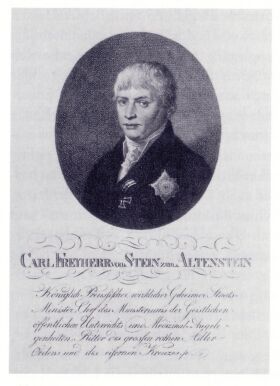
Altenstein was a member of the group of enlightened reformers who had led Prussia from the defeat against Napoleon in Jena (in 1806) to the final victory in Leipzig in 1813. Among them were Wilhelm von Humboldt (1767-1835), Stein(1757-1831), and Chancellor (since 1810, in succession of Stein) Hardenberg(1750-1822). Their political programme was inspired by the principles of the French Revolution, and they believed that the good results obtained through the Revolution should have been maintained with a strong and well-directed policy of reforms “from above”, which would have excluded any “democratic” intervention. They thought that their views had found in Hegel an insightful supporter from within the University.
Two different groups angrily opposed the policies of the reformers.
On one side was the reactionary fraction to whom any proposal aiming at abolishing the “old right” of feudalism and the Ancien Régime was anathema. This faction had very powerful representatives in the Prussian Cabinet (such as the Minister of Interior, von Schuckmann), and was attentively listened to in the Prussian Court, particularly thanks to the turbulent and conservative views of the Crown Prince – the future monarch Frederick William IV – whose influence grew steadily in the mid-1820s.
On the other side, there was a “democratic” faction, the so-called “German Patriots”, who were very well represented within the University in Berlin, thanks to Schleiermacher. Fries was also one of their inspirers. The German Patriots opposed the program of the reformers in the name of what they called the “genuine German Spirit”. According to their views, a thorough reform should have come from below, from the Volk (the People), and without appealing to “foreign” (i.e. French) principles. Their Romantic vision was a mixture of direct democracy, individualism, nationalism and, sometimes, anti-Semitism and xenophobia. They were the champions of feeling, heart and physical strength as opposed to rationalism and cold analysis. They were the champions of spontaneity against written laws and codification. They were the champions of honour (and duels) against any modern attempt to reform university and students’ old traditions.
Hegel was strongly opposed to both the reactionary faction (he remained an admirer of the French Revolution and its values all along his life) and the “democratic German movement”, to which he opposed rationalism and philosophy, codification and institutions. It was clear that his sympathies went to the faction of Reformers represented by Altenstein and Hardenberg.
The situation took an unprecedented turn when in 1819 a Jena student (Karl Ludwig Sand), inspired by the ideals of the “German” movement and Fries philosophy, decided to stab to death the reactionary Russian spy (and well-known drama composer) August von Kotzebue. The “Holy Alliance”, shrewdly instigated by Metternich, decided (with the Decrees ofKarlsbad) to re-establish censorship in Germany and keep a close eye to university professors as a means to avoid the spreading of terror throughout the Empire.
In 1821 Hegel published the ‘GRUNDLINIEN DER PHILOSOPHIE DES RECHTS’ (as volume 8 of Hegel’s collected works (“Freundesausgabe”), with additions from Hegel’s lectures to the paragraphs by E. Gans 1833; 2nd ed. 1840; ed. G. J. B. Bolland, 1901; Eng. trans., PHILOSOPHY OF RIGHT, by S. W. Dyde, 1896, T.Knox 1952 and, most reliable, A.V. Miller 1977). The publication of Hegel’s work on moral and political philosophy (originally due for the early 1820) was delayed by censorship. Hegel’s work condemns both the reactionary point of view (represented by the philosophies of Haller and the legal theories of Hugo and Savigny) and the democratic, German movement. Fries is stigmatized as one of the “ringleaders of shallowness” bent on substituting an imaginary tie of enthusiasm and friendship for the established order of the state.
Hegel’s theory was not – as unwisely yet often repeated – a mere formula for the Prussian state. Much that he construed as necessary to a State was lacking in Prussia. On the whole, he joined the Reformers. Altenstein expressed his satisfaction with the RIGHT. A year before, 1820, Altenstein had already appointed Hegel to the Royal Academic Board of Examiners in Brandenburg; the board that was expected to reform the Prussian educational system. Schools were changing, becoming more humanistic, emphasizing religion less. Hegel enjoyed his role in reforming an educational system that he had earlier criticized.
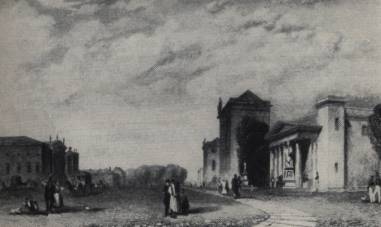
During his thirteen years at Berlin, Hegel’s whole soul seems to have been expressed in his lectures. Between 1823 and 1827 his activity reached its peak; his notes were subjected to perpetual revisions and additions. We trace the shape in which the revisions appear in his published writings. Those on AESTHETICS (published by Hotho 1835-38; trans. 1920 by F.P.B. Osmaston), on the PHILOSOPHY OF RELIGION (published 1832, 2nd enlarged edition 1840; trans. 1895 by E.B. Speirs and J.B. Sanderson), on the PHILOSOPHY OF HISTORY (published 1837 by his son Karl; trans. 1858 by J. Sibree, revised 1899) and on the HISTORY OF PHILOSOPHY (published 1833-36; trans. 1892-96 by by E. S. Haldane and F. H. Simson), have been published by his editors, mainly from the notes of his students, under their separate headings. Those lectures on Logic, Psychology and the Philosophyof Nature are appended in the form of illustrative and explanatory notes to the sections of the “Freundesausgabe” of his Enzyklopädie.
During these years, hundreds of students from all parts of Germany, and beyond, came under his influence. His fame was carried abroad by both eager and intelligent followers. At Berlin, Leopold Dorotheus von Henning (1791-1866) prepare the prospective students for fuller initiation by Hegel himself. Eduard Gans (1798-1839) and Heinrich Gustav Hotho (1802-1873) carried Hegel’s method into special spheres of inquiry, including political science. At Halle Hinrichs maintained the standard of Hegelianism amidst the opposition or indifference of his colleagues.
Three courses of lectures are especially the product of his Berlin period: those on Aesthetics, the Philosophy of Religion and the Philosophy of History.
AESTHETICS: In the years preceding the revolution of 1830, public interest, excluded from political life, turned to theatres, concert-rooms and picture-galleries. Hegel himself became a frequent and appreciative patron, and he made extracts from art-notes in newspapers. While on holiday, his interest in fine art more than once took him out of his way to see an old painting. At Vienna, in 1824, he spent every moment at the Italian opera (especially Rossini), ballet and art galleries. In Paris, in 1827, he attended a Shakespeare play by Charles Kemble with an English company. Hegel’s familiarity with the facts of art (though not particularly deep or historical) gave a freshness to his lectures on aesthetics, which, as put together from the notes of 1820, 1823,1826, are in many ways the most successful of his efforts to see reality in a speculative light.
PHILOSOPHY OF RELIGION: These lectures are another application of his method. Shortly before his death he had prepared for publication a course entitled, ‘Lectures on the Proofs for the Existence of God.’ This was the highest form of religion, in his estimation. In these lectures on religion he dealt with all the world religions, not only Christianity. On one hand, he criticized the ‘Rationalist’ theologians, who had reduced religion to the merest modicum compatible with an ordinary worldly mind. On the other hand, he criticized Schleiermacher, who elevated feeling to a place in religion above systematic theology. Hegel’s middle way attempts to show that dogma is a rational development of what is implicit in religious feeling. Everything depends on interpretation because for Hegel, reason is the foremost criterion of truth, and this includes truth in religion. However, to make this point, philosophy must become the interpreter and in that sense, arguably, the superior.
This view was in sharp contrast to the new school of E. W. Hengstenberg, that regarded the Revelation of Scripture as supreme (e.g. a form of literalism and fundamentalism). For Hegel this position was an “abomination,” since it was positive, authoritarian, and removed both the human heart and the human mind from consideration of the highest aspirations of the spirit.
In Berlin, Hegel finally reached a comfortable economic position and accepted opportunities to travel. In 1820 he visited Dresda and fell in love with the city’s Renaissance architecture. He was accompanied by the historian and poet, Friedrich Cristoph Förster, a writer of radical ideas who managed to climb the social ladder quickly (he was sometimes called “the Court demagogue”), and who later presented an articulate eulogy at Hegel’s funeral. While in Dresda, Hegel made the acquaintance of the famous German poet, Ludwig Tieck, with whom he discussed Shakespeare, although he failed to impress Tieck with his knowledge of poetry and prose. Hegel also visited a exhibition of Italian Renaissance paintings, for which he expressed his enthusiastic admiration.
In 1822 Hegel made a long trip to the Netherlands and the Lower Rhine countries. He roughly followed the itinerary of the famous German Jacobin, Georg Forster. On this occasion, also, Hegel visited the famous French revolutionary Lazare Carnot, who had been exiled in Magdeburg.
Hegel also visited Cologne, where he admired the Cathedral with its medieval German paintings. He visited Antwerp, Brussels, where he stayed with his friend, the Dutch Civil Servant, Van Ghert. He fell in love with the town of Bruges (he would revisit these same cities when returning from his trip to Paris).
In 1827 Hegel travelled to Paris and stayed near the Palais de Luxembourg and the Odéon Theatre. He was guided through the city by his friend and admirer, Victor Cousin. Hegel frequented the opera, visited the Louvre, and admired the face of Paris, comparing it to his dear Berlin. He wrote to his wife: “Paris is the capital of the civilized world”.
HEGEL’S LAST YEARS IN BERLIN
A Hegelian school began to gather. The followers included intelligent pupils, empty-headed imitators, and romantics who turned philosophy into lyric measures. Opposition and criticism only served to define more precisely the adherents of the new school. In the narrower circle of his friends, Hegel’s birthdays were the catalysts for congratulatory verses. In 1826 a formal festival was set up by some of his admirers, one of whom, Herder, spoke of his categories as new gods; he was presented with much poetry and a silver mug. In 1830 the students struck a medal in his honour, and in January 23, 1831 Hegel was decorated by an order (“Roter Adler-Orden III.Klasse” the lowest order available) from Frederick William III (together with 72 others, among them also Schleiermacher).
In October 1829, Hegel was elected Rector of the University; and in his speech at the tercentenary of the Augsburg Confession (in Latin) of June 25, 1830, he felt bold enough to charge the Catholic Church with regarding the virtues of the pagan world as brilliant vices, and with giving the crown of perfection to humbler virtues of poverty, continence and obedience.
However, Hegel’s position in Berlin was never the one (as told by an ill-informed tradition) of “king” of Prussian philosophy. On the contrary, his political and philosophical stance was controversial and opposed by the most important representatives of academia (among them, Savigny and Schleiermacher). Hegel never made it through the Royal Academy of Sciences because of the opposition of these strong figures. As an example of Hegel’s difficult situation, it is interesting to remember that even relaxing occasions such as the celebration of the philosopher’s birthday in 1826 (see above) were used by his detractors as means to put him in a bad light. After the official Prussian gazette had reported on the festival organized by Hegel’s admirers on the occasion on his birthday, King Frederick William became so jealous that he decreed that no more reports on private celebrations should be printed in Prussian newspapers
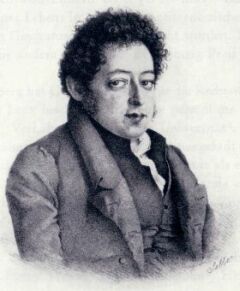
With the death of Chancellor Hardenberg in 1822, von Altenstein remained the only supporter of Hegel within the Prussian government. Hegel’s philosophy was also looked upon with suspicion within the Court, where Hegel was rarely invited. One invitation occurred in late 1831, when the Kronprinz himself invited Hegel to dinner. During this supper, the Crown Prince (i.e. the future Friedrich Wilhelm IV) attacked Hegel’s philosophy of RIGHT, which was being taught – on Hegel’s instructions – by his most talented student, Eduard Gans. As reported by Arnold Ruge recalls (see Hoffmeister’s edition of Hegel’s Letters, vol. III, p. 472, footnote to letter #687), the Crown Prince claimed, addressing Hegel directly: “It’s outrageous that Professor Gans wants to transform all our students into Republicans. His lessons on your philosophy of RIGHT, Professor Hegel, are always attended by several hundreds of students, and it is widely known that he gives to your own thought a completely liberal, I would say Republican, color. Why don’t you lecture your students yourself?”.
Hegel might have been the greatest philosopher, but he was certainly not courageous in this case. Confronted to this direct attack, he apologized to the Kronprinz and declared that he was “unaware of the content of Gans’ lectures”. This is absurd; a sort of humiliating self-exculpation. Even though Hegel might have never followed a Gans’ lecture directly, it is not plausible that nobody – among colleagues or students (including Hegel’s own son Karl) – had never drawn his attention to Gans’ political orientation or that he had never realized himself who his teaching assistant actually was.
As for Friedrich Wilhelm III, once a courtier drew his attention to Hegel’s affirmation (only during his lectures, not in the actually published text of the RIGHT) that the monarch’s power consisted only in saying “yes” and then “dotting the i”, the King angrily exclaimed, “What if I don’t?”. (see Jacques D’Hondt, “Hegel en son temps”, Paris, Editions Sociales, 1968 - p. 100).
It is often said as evidence for an image of an increasingly conservative Hegel during his last years in Berlin, that the philosopher expressed alarm at the outbreak of the July Revolution in France in 1830. While there is some element of truth in this, the conclusions that the “tradition” has attempted to draw from it are overstated. In 1830 three different political revolutions broke out: the so-called July Revolution in France, which brought to the throne Louis Philippe d’Orléans; the Polish insurrection against Russian occupation; and the beginning of the war of independence in Belgium against the Netherlands. Hegel took a different stance towards these three major political events.
As for France, Hegel maintained strong relationships with the representatives of the “liberal” opposition to the Bourbons in France. Victor Cousin was one of his closest acquaintance in France. Our philosopher also took the opportunity to visit, in Magdeburg, the old Carnot, exiled by Louis XVIII for his revolutionary past. Hegel speaks of this visit with enthusiasm. Hegel’s sympathies never went to the monarchists and the reactionaries within the French government. He cheered – together with Cousin – for the victory of the Liberals at the elections held in France in 1827.
The July Revolution erupted following an attempt by King Charles X to impose a new, conservative, Catholic-inspired government in 1829, against the provisions of the French Constitutional Charte. At the beginning Hegel condemns the Revolution, as (per his gradualist approach to political change) an excessive response to a complex problem. Hegel also feared that the July Revolution might represent the beginning of a new era of wars and turmoil, which appeared unattractive to an old and tired philosopher. As long as the situation developed, Hegel accepted the result of the Revolution, and included it in his “LECTURES ON THE PHILOSOPHY OF HISTORY” (of 1830):
“For although the Charte was the standard under which all were enrolled, and though both parties had sworn to it, yet, on the one side, the ruling disposition was a Catholic one, which regarded it as a matter of conscience to destroy the existing institutions. Another breach [that is the July Revolution], therefore, took place, and the government was overturned” (transl. J. Sibree)
The poet Heinrich Heine, referring to Hegel’s statements, jokingly called him “the Orléans of German Philosophy”.
As for the revolution in Belgium and the insurrection in Poland, Hegel expresses towards them feelings of distrust, seeing in the Catholic and Nationalist ideology that partially inspired them a regression towards a pre-revolutionary way of thinking. In this, Heinrich Heine, a well-known radical, agreed, whose judgement of both events is all but positive.
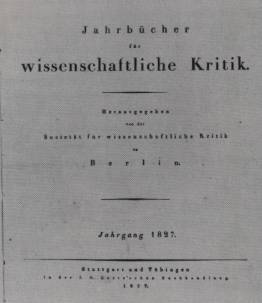
One of the last literary undertakings in which he took part was the establishment of the Berlin ‘Sozietät für wissenschaftliche Kritik’ (society for scientific critique) in 1826 with their annual ‘Jahrbücher für wissenschaftliche Kritik’ (1827-1846) in which he assisted his friends Eduard Gans and Varnhagen von Ense. The aim of this review was to give a critical account, certified by the names of the contributors, of the literary and philosophical productions of the time, in relation to the general progress of knowledge. The journal was not solely in the Hegelian interest; and more than once, when Hegel attempted to domineer over the other editors, he was met by vehement and vigorous opposition. Hegel contributed to the journal several articles, including a critique of Wilhelm von Humboldt’s edition of the Bhagavad-Gita (1827), one of Hamann’s writings(1828) and positive reviews of books from Solger (1828) and Göschel (1829).
Hegel’s last literary work, the first part of which appeared in the Preussische Staatszeitung (the later parts being censored), was an essay on the English Reform Bill of 1831. It contains primarily a consideration of its probable effects on the character of the new members of parliament, and the measures which they may introduce. In the latter connection he enlarged on several points in which England had done less than many continental states for the abolition of monopolies and abuses. Surveying the questions connected with landed property, with the game laws, the poor, the Established Church, especially In Ireland, he expressed grave doubt on the legislative capacity of the English parliament as compared with the power of renovation manifested in other states of western Europe.
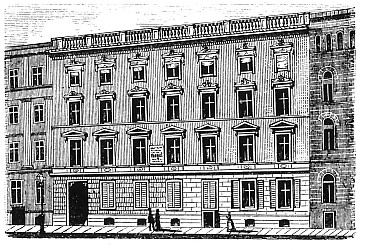
In 1831 cholera first entered Europe. Hegel and his family retired for the summer to the suburb of Kreuzberg, and there he finished the revision of the first part of his SCIENCE OF LOGIC (published 1832). During the beginning of the Winter session, he returned to his house in the Kupfergraben. On this occasion a squabble occurred between him and his friend Gans, who in his notice of lectures on jurisprudence had recommended Hegel’s Philosophy of RIGHT. Hegel, indignant at what he thought was patronage, demanded that the note be withdrawn. On November 14, after one day’s illness, he died quietly, in his sleep. His funeral was dignified, worthy a person of his importance. He was buried on the Dorotheenstädtischen Friedhof (Chausseestraße 126) next to Fichte and near Karl Solger, in a place he had personally chosen at Solger’s funeral. (On Hegel’s death, see also Horst Althaus’ version in ‘Hegel und Die heroischen Jahre der Philosophie’, München/Wien 1992)
Hegel in his class-room and the impression he made on his students is characterized by the report of Hotho:
“When, after a few days, I saw him again in the professorial chair, I could not at first accommodate myself either to the manner of his outward address or the inward sequence, of his thoughts. There he sat, with relaxed, half-sullen air, and, as he spoke, kept turning backwards and forwards the leaves of his long folio manuscript; a constant hacking and coughing disturbed the even flow of speech; every proposition stood isolated by itself, and seemed to force its way out all broken and twisted; every word, every syllable was, as it were, reluctantly let go, receiving from the metallic ring of the broad Swabian dialect a strange emphasis, as if it were the most important thing to be said. Yet the whole appearance compelled such deep respect, such a feeling of reverence, and attracted by such a naive expression of overpowering earnestness, that, with all my discomfort, and though I may have understood little enough of what was said, I felt myself irresistibly bound to him. And no sooner, by zeal and patience, had I accustomed myself to these outward defects of his address, than they and its inward merits seemed to unite themselves into an organic whole, which claimed to be judged by itself alone.”

This lithography is probably the result of a live portrait, carried on during one of Hegel’s overcrowded lessons.
“An easy-flowing eloquence presupposes that one has made up one’s final accounts with the matter in hand, and therefore an ability of a merely formal kind is able to chatter away with cheap attractiveness, without rising above the region of commonplace. Hegel’s work, on the other hand, was to call up the most powerful thoughts out of the deepest ground of things, and to bring them as living forces to bear upon his audience; and for this it was necessary that, -often as they had been meditated and recast through past years,- with every new expression they should be reproduced afresh in himself. A more vivid and plastic representation of this hard conflict and birth-labor of thought than Hegel’s manner of address could not be conceived. As the oldest prophets, the more vehemently they struggle with language, utter with the more concentrated force that thought which they half conquer, and which half conquers them, so did he struggle and overcome by the unwieldy verve of his expression. Entirely lost in his subject, he seemed to develop it out of itself for its own sake, and scarcely at all for the sake of the hearer; and an almost paternal anxiety for clearness softened the rigid earnestness which otherwise might have repelled one from the reception of such hard-won thoughts.”
“Stammering already at the beginning, he forced his way on, made a new beginning, again stopped short, spoke and meditated: the exact word seemed ever to be in request, and just then it came with infallible certainty. . . . Now one felt one had grasped a proposition, and expected a further advance to be made. in vain. The thought, instead of advancing, kept turning with similar words again and again round the same point. Yet if the wearied attention was allowed to stray for a moment, one found, on returning, that one had lost the thread of the discourse. For slowly and carefully, by apparently insignificant intermediate steps, a thought had been made to limit itself so as to show its one-sidedness, had been broken up into differences and entangled in contradictions, the solution of which suddenly brought what seemed most opposed to a higher reunion. And thus, ever carefully resuming again what had been gone over before, and deepening and transforming it by new divisions and richer reconciliations, the wonderful stream of thought flowed on, twisting and struggling with itself, now isolating and now uniting, now delaying and now springing forward with a leap, but always steadily moving to its goal.”
“Even one who could follow with full insight and intelligence, without looking to the right or to the left, saw himself thrown into the most strange tension and agony of mind. To such depths was thought carried down, to such infinite oppositions was it torn asunder, that all that had been won seemed ever again to be lost, and after the highest effort the intelligence seemed to be forced to stand in silence at the bounds of its faculty. But it was just in these depths of the apparently undecipherable that that powerful spirit lived and moved with the greatest certainty and calm. Then first his voice rose, his eye glanced sharply over the audience, and lighted up with the calmly glowing flame of conviction, while in words that now flowed without hesitation, he measured the heights and depths of the soul. What he uttered in such moments was so clear and exhaustive, of such simple self-evidencing power, that every one who could grasp it felt as if he had found and thought it for himself; and so completely did all previous ways of thinking vanish, that scarce a remembrance remained of the days of dreaming, in which such thoughts had not yet been awakened.”
(Hotho, ‘Vorstudien fur Leben und Kunst’, quotes above selected and translated by Edward Caird in his book ‘Hegel’)
ABOUT THIS BIOGRAPHY, SOURCES USED, ACKNOWLEDGEMENTS
This Hegel biography is based on the Hegel article in the “Encyclopaedia Britannica” of 1911, written by English Hegelians at the time. All links, additions and corrections by Hegel.Net authors Kai Froeb and Maurizio Canfora according to the latest Hegel research.
In addition to the sources cited in the text, the following authors and works were consulted in particular:
- The new Hegel biographies by Klaus Vieweg and by Jürgen Kaube, published in 2021, are both very good, comprehensive and complementary summaries of our knowledge of Hegel’s life. Kaube is more readable, Vieweg is more detailed.
- Walter Jaeschke’s “Hegel Handbuch” (3rd edition). The ultimate summary of philological research on Hegel.
- Jacques d’Hondt (“Hegel”, “Hegel Secret”, “Hegel in Berlin”), from him I have e.g. the hint that the Frankfurt wine merchant Gogol played a role with the Frankfurt Freemasons
- Domenico Losurdo (“Hegel and the German Heritage”), from him, d’Hondt and Vieweg I find many references to the political Hegel
- Alexandra Birkert (“Hegel’s Sister”), contains many references to Hegel’s background in Stuttgart and the first 30 years of his life, in addition to focusing on his sister, who has received too little attention so far. The references to Abel come from this book.
- The five volumes of Hegel letters, published by Felix Meiner Verlag Hamburg, are an important primary source. In the 5th volume there is also a very useful index of 2000 persons who appear in the letters, with a short description and where to find them.
Many thanks to Martin Bondeli, Bern, and Beat Greuter, Zürich, for their extensive help regarding the role on Hegel in Bern. Further suggestions and positive criticism are very welcome